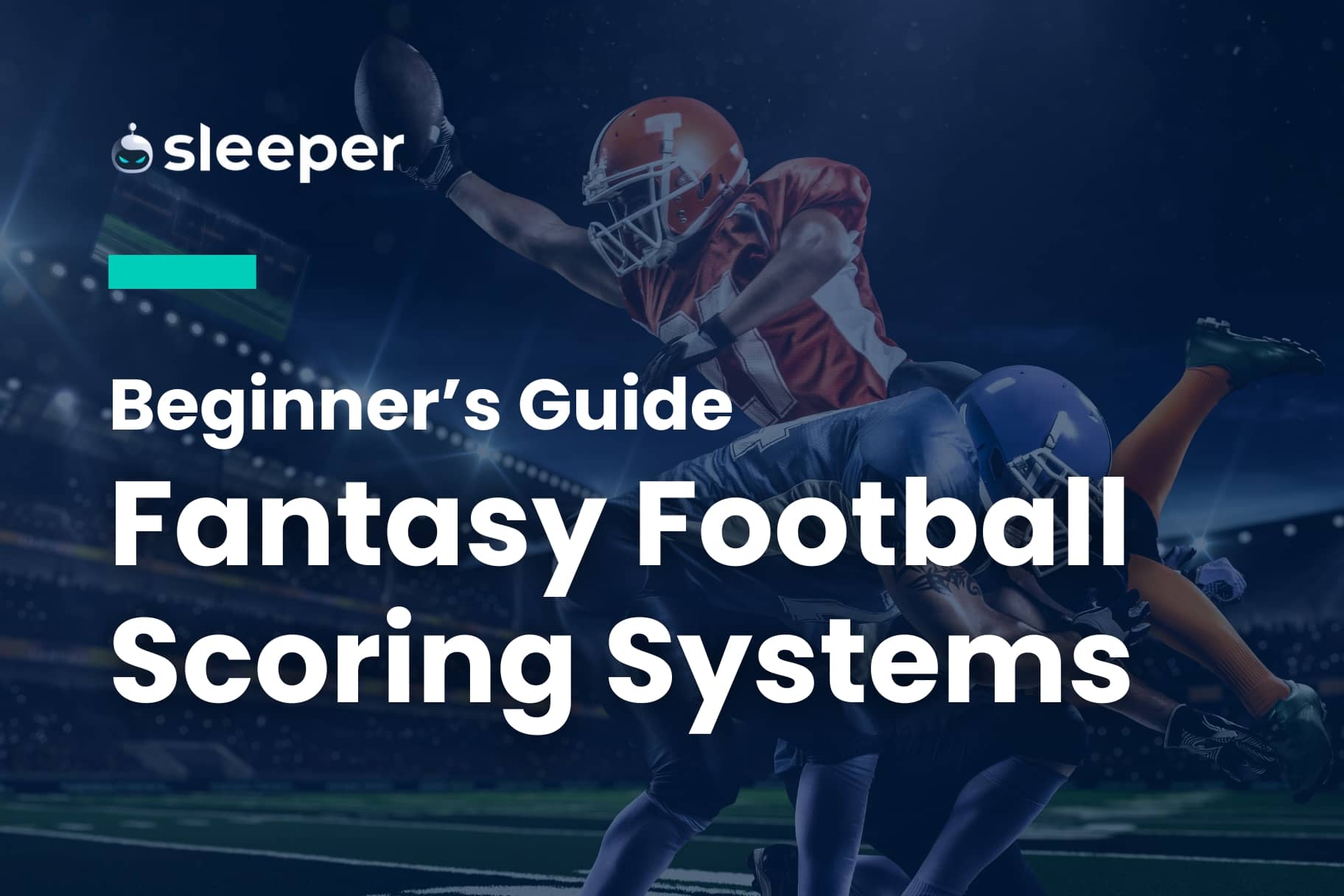Are you new to fantasy football or struggling to understand the scoring systems and points in your league? With this comprehensive guide, you'll grasp how fantasy football points are calculated and gain insights to select the ideal scoring format for the new season.

Fantasy Football Scoring Systems and How They Work
Fantasy football has become as much a part of NFL culture as the actual games themselves, so it’s no wonder that fans everywhere are checking their own scores as much as that of their favorite team every week during the season.
Every march to a league title begins with the draft, but before you conduct yours, it’s imperative to understand exactly how your league’s scoring system is set up. There’s a big difference between a league where QB passing touchdowns are worth the same as rushing and receiving touchdowns and those in which they’re not.
Scoring rules will shift your draft strategy in a big way — as will the determination over whether receptions count for your skill-position players, or if it’s just yardage and TDs that wind up on the scoresheet.
If you’re just getting started out with fantasy football or seeking a change from your status quo, the scoring and how it impacts the decisions you make can be overwhelming. Fortunately for you, we’ve got it all covered below so you can enter your draft with the utmost confidence.
How Do Fantasy Football Scoring Systems Work?
Fantasy football scoring is based on what happens on the field, with player statistics translating into fantasy points in real time. All of that adds personal stakes to games and individual performances that may not have meant much to you otherwise.
Head-to-head leagues will pit your lineup against that of another squad on a weekly basis, with the winner emerging with the higher point total. In order to accumulate those points, it comes down to those game-by-game stats and how your league chooses to value them.
Quarterbacks will generally tally points for passing yards, rushing yards and touchdowns (and negative points for turnovers). Running backs, receivers and tight ends will have their yardage and scoring plays (and sometimes receptions; more on that below) translate into fantasy points.
There are also points reserved for defenses (either the whole defensive unit or individual defensive players, depending on your league’s preference) and kickers (field goals and extra points).
There’s nothing like the joy or despair of having your fantasy football week come down to the whims of a kicker — to round out your team’s score.
Fantasy Football Scoring Systems
There are three general scoring formats that fantasy football players and leagues utilize.
- PPR (points per reception)
- Half PPR
- Standard scoring
Here’s a closer look at them and what separates each one from the next.
PPR scoring (Point per reception)
In this format, any player who catches a pass gets a full fantasy point for that reception. That significantly increases the value of players with a high target volume and also increases the attractiveness of running backs who happen to be active in the passing game.
The biggest names — like wide receivers Justin Jefferson, CeeDee Lamb and Tyreek Hill — become even more valuable due to what they’re able to do with their high reception numbers, but lesser-heralded players can bridge the gap to their star counterparts simply by reeling in catch after catch.
Operating under PPR rules should make you think twice about how early you’re taking the bell cow running backs in your draft. That’s because they offer little to no PPR value while a target machine of an RB in a pass-happy offense could be just as or even more useful — and available later on while you’re picking.
There’s a strategic element to the PPR format that simply doesn’t exist in the more stripped-down version of fantasy football. PPR leagues reward a player who, say, goes five catches for 50 yards more than one who catches one 50-yard pass. The PPR advocate would say that is a more just system.
Half PPR scoring
Instead of being given a full point for receptions, half PPR does just that — gives half a point for each catch a player makes. It still tilts the scales in favor of the high-volume pass catchers, but not as drastically.
Some might say that full PPR is a bit too heavily tilted toward those players, so half PPR is a happy medium between that and standard scoring leagues, while still adding that extra intrigue (and half a point) to every pass completion as the scores are being tallied up.
Standard scoring (non-PPR)
In a standard format, there are no points for receptions, so that leaves the skill players’ value dependent on yardage and touchdowns. Whereas a player who regularly catches 6-8 passes a game may have a less risky floor under PPR and half PPR rules, that safety net is yanked away in a standard, non-PPR scoring format.
Fantasy Football Points Variations
Point values for different stats ultimately come down to your league’s commissioner (or in a more democratic league, some sort of vote among all team owners). Some leagues will devalue passing touchdowns from six points to four to level the playing field and keep quarterbacks from being far and away the most valuable players in the game.
Pro Tip: How much you decide to customize your league's scoring depends on which fantasy platform you use. Sleeper's fantasy app allows complete customization of your league rules and scoring settings.
Standard scoring usually values stats as follows, with leagues regularly honoring fractional points for yardage and negative points for turnovers:
PASSING
- Touchdowns: 4 points
- Two-point conversions: 2 points
- Yards: 1 point for every 25 yards
- Interceptions: -2 points
- Fumbles lost: -2 points
RUSHING
- Touchdowns: 6 points
- Two-point conversions: 2 points
- Yards: 1 point for every 10 yards
- Receptions: 1 point or 0.5 points, depending on format
- Fumbles lost: -2 points
RECEIVING
- Touchdowns: 6 points
- Two-point conversions: 2 points
- Yards: 1 point for every 10 yards
- Receptions: 1 point or 0.5 points, depending on format
- Fumbles lost: -2 points
KICKING
- Extra point: 1 point
- FG 0-39 yards: 3 points
- FG 40-49 yards: 4 points
- FG 50+ yards: 5 points
DEFENSE/SPECIAL TEAMS
- Kick return touchdowns: 6 points
- Defensive touchdowns: 6 points
- Interceptions: 2 points
- Fumble recoveries: 2 points
- Safeties: 2 points
- Sacks: 1 point
- Shutouts: 10 points
- 1-6 points allowed: 7 points
- 7-13 points allowed: 4 points
- 14-20 points allowed: 1 point
- 21-27 points allowed: 0 points
- 28-34 points allowed: -1 point
- 35+ points allowed: -4 points
The most commonly customized points are that of passing touchdowns (ranging anywhere from 4-6 points) and passing yards (to make QB points a bit harder to come by, some leagues could raise the yardage threshold per point to 30 or 35 yards or even more). Some commissioners will make interceptions and/or fumbles lost only -1 point to lessen the blow of turnovers.
Others may institute a bonus system, where quarterbacks gain extra points (usually no more than three) for hitting 300 yards, while players who hit 100 rushing or receiving yards are also rewarded the additional points, but that is a less common practice.
The Sleeper app offers unique scoring options such as points per first down and custom scoring for each position.
What Is the Best Fantasy Football Scoring System?

This all comes down to personal preference, but if you’re a beginner, perhaps the standard scoring with default options is the best way to start out. There’s less to take into account, and things are considerably more straightforward. Find the studs who rack up the yards and the scoring plays, and that’s that.
One advantage to playing in a standard scoring league is that most online fantasy advice uses this format when assessing player values.
PPR or half PPR offers more variation, makes more players across the NFL more palatable to have on your roster — that certainly comes in handy for roster depth during the bye weeks — and increases the possibilities for your league as a whole on a weekly basis.
Fantasy Football Scoring FAQ
With all of the different options that leagues have for scoring, there are bound to be some questions. Like a sharp quarterback anticipating a pass rush, we can anticipate your top inquiries and dig a bit deeper to help you out.
Is PPR or standard scoring better?
It all boils down to the level of players in your league, how deep down NFL rosters you want to go and if you don’t want to have your league be so touchdown-dependent.
Half PPR offers a compromise, where players are still rewarded for their catches but not to the point where, say, a six-catch game is the equivalent of having scored a touchdown.
What is the most common scoring in fantasy football?
PPR or half PPR are becoming the norm more and more to the point that some fantasy football providers have PPR as their “standard” format.
For the purposes of this guide, “standard” refers to non-PPR, but the balance is being tipped more to the pass-catchers — which syncs up with the way offenses across the NFL have been trending for the past few years.
Do defenses matter in fantasy football?
They certainly do! They may be harder to predict on a weekly basis, with so much variation week to week, garbage time points conceded and turnovers infuriatingly having an impact on the bottom line.
There’s a reason that team defenses (and kickers) are often left until the end of fantasy drafts. But rostering a reliable fantasy defense can be what’s needed to put your team over the top.
What’s a Superflex league?
Perhaps you’ve seen the term “superflex” as it relates to fantasy football. In standard leagues, the default setting for lineups is to have one QB, two RBs, two WRs, one TE, one flex (either an RB/WR/TE), one kicker and one defense.
Those settings can be tweaked and customized by your league, and one such custom option is the superflex, which opens up the possibility of adding a second quarterback to your starting lineup in that flex spot (it would be open to any of QB/RB/WR/TE).
It may seem unorthodox, since no NFL team plays two QBs at once, but in the fantasy world, it offers another fun, high-scoring wrinkle and gives more value to QBs — especially those on the second and third tiers who may otherwise be fodder for the waiver wire.
Put Your New-Found Expertise Into Practice
Now that you’re an expert on fantasy football scoring variations, have a handle on the different formats and are ready to master the game and rule your league, sign up for Sleeper to start playing. Join either by signing up via our website or downloading the Sleeper app.
Sleeper has special features across its season-long fantasy football games that you won’t find anywhere else, and it’s also the ideal fantasy football gaming platform for daily fantasy sports, differing from its DFS competitors by offering snake drafts for every week of the NFL season through Daily Draft.




